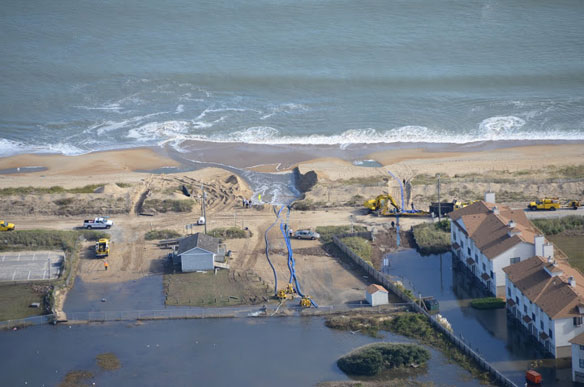
Aerial pictures of North Carolina’s coast, after superstorm Sandy devastated the area. Highway 12. Photo courtesy of: © PSDS / WCU
By USGS;
As recovery efforts for those impacted by Hurricane Sandy continue, U.S. Geological Survey crews are sampling water for nutrients, sediment, and pesticides to document water quality in areas affected by the hurricane. This sampling effort is part of the federal government’s broad efforts to ensure public health and to support the state, tribal, and local response to the storm.
“We tend to think of events like Sandy in terms of the ephemeral effect of the wind, rain, waves, and even snow as it swept through our communities, but in fact this superstorm can have a longer-term effect in the large pulse of sediment and associated pollutants swept into our waterways,” said USGS Director Marcia McNutt. “It is particularly important to quantify the input of this one unusual event before concluding that certain efforts to reduce pollutant run-off from year to year have or have not been effective.”
Sampling is taking place at various locations. In New Jersey, crews will collect water quality samples along the Delaware River near Trenton and along the Raritan River near Queens Bridge. Pennsylvania crews will be sampling near the Chesapeake Bay. In Maryland, water quality samples will be collected from the Potomac River, various sites in Washington, D.C., several locations along the Eastern Shore, and from the Susquehanna River at the Conowingo Dam. In addition, Virginia crews will be sampling throughout Northern Virginia. USGS crews will be sampling in these and other areas for contaminants like pesticides, E. coli, nutrients, and sediment to document water quality in areas affected by the hurricane.
“Significant high water events are important to document, because a storm event like this can flush large quantities of nutrients, pesticides, and sediment into rivers,” said Charles Crawford, coordinator of the sampling effort. “When looking at long-term water quality trends and year-to-year variation, this hurricane could be a defining event for the past few decades, and it’s important that USGS captures a complete picture of what happens.”
Excessive nutrients in the Nation’s rivers, streams and coastal areas are a major issue for water managers, because they cause algal blooms that increase costs to treat drinking water, limit recreational activities, and threaten valuable commercial and recreational fisheries. Increased sediment can cause costly changes in shipping channels, where new sediment can require additional dredging.
“The USGS creates models that relate nutrient, pesticide and sediment concentrations to how much water is flowing,” said Crawford. “In order to have the most accurate model, it’s important to document concentrations during a high flow event such as this one.”

Photo courtesy of: © PSDS / WCU
Pollution & Debris Stirred by Sandy Threaten Coastal Waters, OurAmazingPlanet
Local officials in New York City are warning residents to steer clear of the potentially toxic soup, particularly around areas like the Gowanus Canal Superfund site. But the contaminated waters are also raising concerns among those who monitor the health of beaches and bays along the Northeast and Mid-Atlantic.
Arthur Kill Oil Spill: Diesel Cleanup Continues, Huffington Post
During the peak of superstorm Sandy, a storm surge and full-moon high tide coincided to cause waters to rise an unprecedented 13 feet in some parts of New York Bay. Among the mounting devastation, hundreds of thousands of gallons of diesel fuel spilled into Arthur Kill, a narrow waterway separating New Jersey and Staten Island.
BE THE CHANGE: TO ACT: Info / Link List:
Waves For WaterHurricane Sandy Relief Initiative Hurricane Sandy Relief Initiative.
Waves for Water has coordinated a full-fledged Hurricane Relief Initiative in response to Super Storm Sandy that has absolutely decimated the North Eastern seaboard.
American Red Cross
The Red Cross is providing shelter, clothes, supplies, food and blood, as needed, for the victims of Sandy.
Salvation Army
The Salvation Army is providing meals and shelter.
Humane Society
Many pet owners were able to take their pets with them, but for those who were not, the Humane Society’s Animal Rescue Team is assembling staff and equipment to help rescue pets in the Mid-Atlantic and Northeast.
American Humane Association
The association is helping animals that may need rescue or shelter.
Habitat For Humanity
Habitat, an international organization, helps those in need rebuild their homes after disaster strikes.
Community Foodbank Of New Jersey
This group coordinates efforts with the state’s Office of Emergency Management, as well as with state and local nonprofit organizations.
Feeding America
The organization will deliver food, water and supplies to communities in need through its network of food banks and the agencies they serve.
Americares
This group provides emergency medicine and supplies. Donations are accepted on its accepts donations on its website.
New York Cares
This local NYC program is “the city’s largest volunteer organization, running volunteer programs for 1,300 nonprofits, city agencies and public schools.” It is recruiting volunteers to help with Sandy relief efforts, and is also raising money.
Direct Relief International
The organization provides medicine and supplies to partner health centers and clinics.
NYC Mayor’s Fund
The Mayor’s Fund to Advance New York City charity supports “impactful public programs serving some of the City’s greatest needs.”









